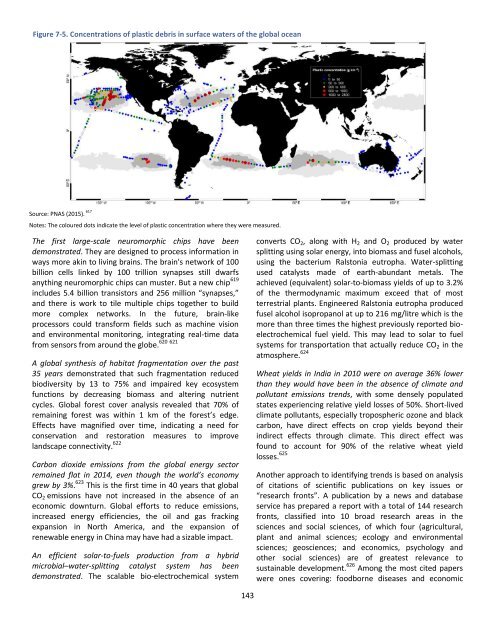1HlG51J
1HlG51J
1HlG51J
Create successful ePaper yourself
Turn your PDF publications into a flip-book with our unique Google optimized e-Paper software.
Figure 7-5. Concentrations of plastic debris in surface waters of the global oceanSource: PNAS (2015). 617Notes: The coloured dots indicate the level of plastic concentration where they were measured.The first large-scale neuromorphic chips have beendemonstrated. They are designed to process information inways more akin to living brains. The brain's network of 100billion cells linked by 100 trillion synapses still dwarfsanything neuromorphic chips can muster. But a new chip 619includes 5.4 billion transistors and 256 million “synapses,”and there is work to tile multiple chips together to buildmore complex networks. In the future, brain-likeprocessors could transform fields such as machine visionand environmental monitoring, integrating real-time data620 621from sensors from around the globe.A global synthesis of habitat fragmentation over the past35 years demonstrated that such fragmentation reducedbiodiversity by 13 to 75% and impaired key ecosystemfunctions by decreasing biomass and altering nutrientcycles. Global forest cover analysis revealed that 70% ofremaining forest was within 1 km of the forest’s edge.Effects have magnified over time, indicating a need forconservation and restoration measures to improvelandscape connectivity. 622Carbon dioxide emissions from the global energy sectorremained flat in 2014, even though the world’s economygrew by 3%. 623 This is the first time in 40 years that globalCO 2 emissions have not increased in the absence of aneconomic downturn. Global efforts to reduce emissions,increased energy efficiencies, the oil and gas frackingexpansion in North America, and the expansion ofrenewable energy in China may have had a sizable impact.An efficient solar-to-fuels production from a hybridmicrobial–water-splitting catalyst system has beendemonstrated. The scalable bio-electrochemical systemconverts CO 2 , along with H 2 and O 2 produced by watersplitting using solar energy, into biomass and fusel alcohols,using the bacterium Ralstonia eutropha. Water-splittingused catalysts made of earth-abundant metals. Theachieved (equivalent) solar-to-biomass yields of up to 3.2%of the thermodynamic maximum exceed that of mostterrestrial plants. Engineered Ralstonia eutropha producedfusel alcohol isopropanol at up to 216 mg/litre which is themore than three times the highest previously reported bioelectrochemicalfuel yield. This may lead to solar to fuelsystems for transportation that actually reduce CO 2 in theatmosphere. 624Wheat yields in India in 2010 were on average 36% lowerthan they would have been in the absence of climate andpollutant emissions trends, with some densely populatedstates experiencing relative yield losses of 50%. Short-livedclimate pollutants, especially tropospheric ozone and blackcarbon, have direct effects on crop yields beyond theirindirect effects through climate. This direct effect wasfound to account for 90% of the relative wheat yieldlosses. 625Another approach to identifying trends is based on analysisof citations of scientific publications on key issues or“research fronts”. A publication by a news and databaseservice has prepared a report with a total of 144 researchfronts, classified into 10 broad research areas in thesciences and social sciences, of which four (agricultural,plant and animal sciences; ecology and environmentalsciences; geosciences; and economics, psychology andother social sciences) are of greatest relevance tosustainable development. 626 Among the most cited paperswere ones covering: foodborne diseases and economic143




